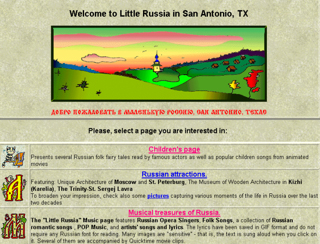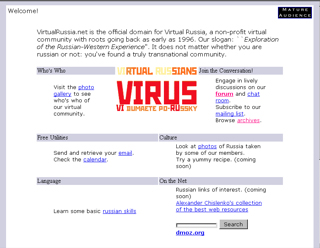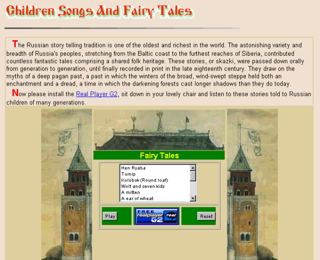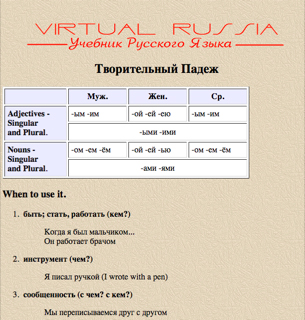Many of us are concerned about incivility on social media. Trolling, rancor, and vitriol seem the norm rather than exception. The issue has drawn attention from experts who decry polarization and “fake news.” Some blame Russian interference for pumping out inaccuracy in the American election and stirring up rancor between American and Russian cultures.
The situation brings to mind an early experience that I hope will prove valuable to readers. In the late 1990s through 2000s, I took part in a Russian-American virtual community. The group was formed shortly after the end of the Cold War on a university server called “Little Russia in San Antonio, Texas.” The site offered abundant resources for Russian immigrants to the USA. It also provided content promoting Russian culture including links to Russian music, art, and literature (see Figure 1).

Unfortunately, a forum established to offer assistance and advice devolved into political and personal attacks between Russians and Americans. Nerves were raw. Due to decades of animosity, mistrust, and isolation between the US and Russia, few members had opportunities for sustained encounter and dialogue. Participants came to the group loaded with distortions and biases. At one point, a small group of members was banished from the site. Eventually the site was discontinued, and that seemed to be that. Interestingly enough, however, the banished group formed a new site, Virtual Russia, where they resolved their considerable differences, mended fences, and eventually came to care for each other (see Figure 2).

How did it happen? One reason is that the user interface on Virtual Russia encouraged an enriched sense of togetherness. The interface brought cultural touchstones to the foreground, ones that participants could easily grasp. These touchstones influenced communal norms, values, mutuality, and sharing. The interface featured interaction tools that helped members contact and support one another. The togetherness transcended that of a network: It facilitated a community. Participants took their friendships offline and supported one another.
My experience with the Russian-American sites offers insights that can inform design principles for other UX professionals developing social platforms, particularly in contentious times. Let’s examine the insights in further depth.
Build a Community, not a Network
The distinction between network and community is an important one. A network refers to a group of interacting connections linked together. The more often two or more connections interact, the stronger the ties among them. The quality of interaction does not matter except in minimal ways.
By contrast, community produces a richer and more personal experience than a network. The best communities value familiarity, trust, safety, care, a unique shared identity, reciprocity, shared habits and practices, and a sense of a collective destiny. An online social formation with these qualities is called a virtual community.
People who join networks often seek more than debate, information, and/or cooperation with work and tasks. Many want connectedness, friendship, intimacy, and opportunities for social engagement. Communities online offer the potential to meet their needs. Several participants found love and marriage through the Russian-American virtual community. Participants often met each other face-to-face to help one another with moving, chores, financial assistance, emotional support after life changes, lessons on web design or Russian/English languages, and so forth. When one member died, a virtual memorial was established for commemoration, participants organized funding for the families involved, and participants shared their mourning, thoughts, and prayers for the deceased.
Members compensated for limited technological resources to carry out these practices. Today, more interface tools—such as face-to-face and synchronous chat—are available that can be provided to help users of virtual communities support one another.
Establish Credibility
The Greek philosopher Aristotle conceived of credibility by means of ethos, which is roughly understood to mean the communal credibility given to a speaker based on the choices made in communication. The credibility of the two sites is established through the cultural components, artwork, and links to relevant resources. Equally important, ethos refers to the structure of communication. This is best exemplified through the organized and functional nature of the links and menus to access various site resources. For example, the Children’s Songs and Fairy Tales area (see Figure 3) worked as expected. There was no requirement for users to hunt and peck for resources. The items were displayed prominently and a user could easily access recordings with one or two clicks on visible labels.

Develop interface elements that evoke a common cultural reference point. Do not dilute these cultural references. Trying to please everybody ends up pleasing nobody. Make a theme consistent and visible on every part of the site. If the theme of your site is “a warm welcoming and diverse community,” make that idea prominent. If your virtual community is part of an online business, the theme and quality of the business culture should be made visible. A more positive, real-world communicative culture in the business will facilitate the quality of online deliberation.
Encourage new visitors to learn about the culture of the community before participation. People love stories. Find ways to include them. Implement a responsive design for universal access. Consider a mobile app, but be sure not to take anything from users (such as geographic location and contacts) without their permission.
Establish Social Trust
Social trust is “a belief in the honesty, integrity, and reliability of others—a ‘faith in people’” (Pew Research Center). Social trust provides a foundation on which to develop and ensure norms for constructive and respectful discourse. It neither emerges from nor is maintained through confrontation, critical inquiry, and argumentation. Rather, social trust is the prerequisite for respectful debate and dialogue. Social trust is built on a culture that highly values mutuality, respect, and reciprocity.
The prerequisite for community is the cultivation of social trust. This objective does not proceed solely via provision of a discussion board for political one-offs, nor a list, a my-feed, my-stream, my-page or my-anything. It’s not about one person; it’s about the community. A rich and functional interface sets a context in which interaction occurs. Participation should mean familiarization with the cultural representations established through the interface.
Trust makes people feel welcome, accepted, included, cared for, and freer to express themselves and share time and resources. Trust makes participants more tolerant of differing viewpoints. Participants will fight for trust more than the right to trade insults, compete for attention, and/or attack another person’s ideas. Trust requires responsibility for educating oneself and others about the proper protocols for membership. For this reason, trust takes time. UX developers will not succeed with the goal of “instant community.” They need to take a longer view of matters.
Focus on Emotions
Focus on the emotive content of your interface. You want users to come away feeling good, relaxed, and generally positive. Make the site beautiful, like the colors and imagery of Little Russia. Russian visitors liked seeing their culture represented positively, and American visitors found the Russian culture attractive. Enjoyment through art produces positive impressions that motivate the desire for cross-cultural interconnectedness.
People trust local themes. Think about the difference one experiences between entering a hometown coffee shop compared with the austerity of a national chain. Odds and ends give atmosphere to the local place. More importantly, they factor significantly in memories. Nobody remembers the last coffee ordered from a chain. They remember the place, date, and time they drank hot apple cider, sat next to someone holding a tiny chihuahua, and studied curios from the local community’s most famous resident.
Think about ways that participants can share experiences. Everybody likes food. Create a community recipe database. Provide shared gaming platforms, community contests and calendars. In encouraging shared experiences, the site will also foster a sense of communal time and shared destiny.
Encourage Participatory Virtual Barn Raising
On Virtual Russia, participants with varying backgrounds and skills contributed toward the development, hosting, and maintenance of the site (for example, a Russian language guide, seen in Figure 4). In early 2000, technological limitations required certain advanced skill sets, so participation was limited. Today, there are tools that make it easier to pitch in and help raise the barn, so to speak.

Provide easy-to-use tools that facilitate participant involvement in the creation of site features. Ask trusted participants for help with tasks or offer a participation signup tool. Participants who have a stake in the group are more likely to support its mission and keep things harmonious. Consider hosting the community on a content management system that has widely accessible tools for site development.
Encourage Assistance and Support
Both sites provided helpful resources. For example, they included pages linking to information about US customs and immigration. On forums, posts sought legal advice, information about specific towns and schools, and customs for raising children.
Provide easy-to-use tools that encourage participants to offer assistance, advice, physical and/or emotional support. Major companies offer gifting cards online. Include a tool for this purpose.
Consider making the providing of assistance a prerequisite for full inclusion and/or participation in discussion boards. This requirement might set a context for participants that the site has a strong culture of reciprocity. The community will benefit if members interact with one another in ways apart from discussions, as well as index its commitment to the well-being of members. Create features that facilitate giving, not to broad causes but, rather, to specific individuals. These features will encourage intimate and trustful contact.
Keep Conflicts Civil
Conflicts inevitably arise on discussion forums. Unfortunately, the Russian-American sites lacked adequate tools for managing conflict in part due to technological limitations. After a tense exchange, the Little Russia webmaster banned several members. Some equated this behavior with Russian totalitarianism and a violation of free speech. Embittered by the lack of transparency, the banished group moved to a different site. A transparent discussion led by the webmaster solicited viewpoints and votes for the appearance, content, and mission statement of the website. The group settled on a multi-ethnic and transnational identity that coupled the American value of free speech with a Russian idea of friendship. Paraphrasing one member, Russian friends beat each other up and still remain friends.
Create features that require participants to more thoughtfully consider and reflect on the persona and ideas of others. Mandate that profile photos accompany posts. Implement a delay feature in post replies. Provide guidelines that encourage users to ask questions of others before responding. Consider a form that encourages the “speaker-listener” technique. Discourage spouting off by limiting word length in follow-up posts.
Encourage participatory forms of discussion management. Allow features (such as like buttons and frowny faces) that reward pro-social statements and make visible the group’s annoyance with troublemakers. Allow participants to rank a post. Rework the threaded discussion format so that posts with sufficiently low rankings are moved to a “dunce” board, with the original poster put in a “time-out” period.
Identify discussion leaders who can direct others toward pro-social posting. On Virtual Russia, key members had privileges for making sure participants understood the meaning and application of community values.
Reduce Distractions
Internet users grow irritable and fatigued when bombarded with too much stimuli. Minimize advertising. Memes and cross-posts that are inconsistent with the culture of the site should be blocked. Avoid sharing a timeline of another member’s posts to the broader community. Timeline sharing violates the users’ implicit belief that the community respects privacy.
The Future of Social Networks and Community
No matter how civil or harmonious, virtual communities are not independent of the real world. The participants and, by extension, society at large, may have greater influence in the shape of virtual communities than the usability of the interface. Many people find them as an alternative to the deteriorating social quality of their geographic locations, aggravated by real-life insecurities over economic and social status, but online social formations cannot alone rectify larger socio-economic problems.
The promise of positive alternatives by social networks has yet to be realized. In part, poorly formed user interfaces preclude true community. Like the coffee chain, their sterility dulls interest and motivation. Features are hard to manage. Feeds are populated with divisive politics, advertising, and “click bait.” The posting format is geared toward sensationalistic quick hits and attacks rather than deliberation and reflection. Post and privacy management is hardly transparent, if it exists at all. Worse, user control is pitched to participants as giving them freedom to customize when it does anything but, and this creates mistrust between users and developers.
Most social media is constructed around self-promotion and glorification. Some business incentives are based on ties (established through responses and “likes”) and doing whatever it takes to build a network, and this is done through stimulating and shocking users to interact with posts whatever the cost.
Some network models run counter to real community, but that can change. A step in the right direction is for social network firms to allow UX designers to create APIs that allow freer customization of layout, widgets, allowable content, privacy settings, and transparent protocols for privacy and post management. By developing interfaces that facilitate community over network, UX professionals will enrich the quality of social interaction, and this can only be good for everybody.
This article is dedicated to Stacey.
